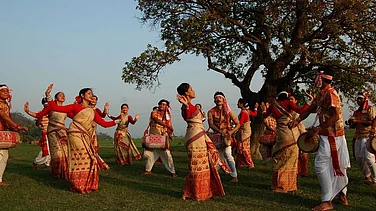Hariyali Teej is a popular festival celebrated mainly by women in several parts of India, especially in the north. It takes place during the monsoon season, in the month of Sawan (July–August), when the weather turns pleasant and greenery is all around, which is why it's called Hariyali (meaning "greenery") Teej.
This festival is known for its colorful celebrations, traditional dress, fasting, songs, and the joyful swinging on decorated swings tied to trees. But behind the beauty and traditions lies a deep cultural meaning that continues to evolve with time.
What is Hariyali Teej?
Among the three Teej festivals of major significance stands Hariyali Teej together with Kajari Teej and Hartalika Teej. The festival celebrates its main observances among communities throughout Rajasthan and Uttar Pradesh as well as Madhya Pradesh and Bihar and certain areas in northern India.
The celebration occurs during the Shukla Paksha bright half which reaches its third day in the month of Sawan. Hariyali Teej arrives alongside the enchanting combination of rainy weather and plant growth along with spiritual rejuvenation in nature. The celebration of the festival combines holidays for romantic love along with marriages and the arrival of monsoons.
Why is Hariyali Teej Celebrated?
The Hindu tradition celebrates how Goddess Parvati found her union with Lord Shiva. Hindu mythology tells of Parvati who dedicated numerous years to worship Lord Shiva by both fasting and meditating until he accepted her as his wife. Shiva showed appreciation for her effort and wed her as his wife. On Hariyali Teej devotees commemorate the spiritual reunion which reflects enduring devotion and personal dedication to love.
The religious day is given enormous importance by married women. Women of the community pray for marital happiness and long life span for their husbands. Among the participants of this festival are unmarried girls who seek to discover their future life partner through Hariyali Teej observance.
How is Hariyali Teej Celebrated?
1. Fasting:
Many women observe a nirjala vrat, a fast where they do not eat or even drink water. The fast is considered a form of devotion and strength. In the evening, women gather to hear the Teej Katha, a traditional story about Shiva and Parvati.
2. Dressing Up:
Women wear green, red, or bright-colored clothes, and often dress in traditional attire. Green is especially popular because it represents nature and growth. They also apply mehendi (henna) on their hands and feet, wear bangles, and complete their look with traditional jewelry and makeup, known as Solah Shringar (sixteen adornments).
3. Songs and Swings:
One of the most joyful parts of the festival is swinging. Swings are hung on trees and decorated with flowers and ribbons. Women take turns swinging while singing folk songs that talk about love, marriage, and the monsoon. It brings a sense of fun, friendship, and togetherness.
4. Visiting Family:
Married women often return to their parents’ homes for Teej. This gives them time to reconnect with their roots, celebrate with childhood friends, and enjoy the care and love of their families.
The Evolving Festival
Over the years, the way Hariyali Teej is celebrated has changed in some ways. While the traditional rituals are still followed, many women now celebrate in a way that suits their lifestyle.
Community Events:
In cities, community groups and apartment societies organize group celebrations. These include cultural programs, dance performances, and competitions for best attire or mehendi design.
Focus on Wellness:
Some women choose not to keep a strict fast, especially if they have health issues. Instead, they participate in the rituals and prayers in a way that feels meaningful without affecting their well-being.
Modern Style Meets Tradition:
Today, many women mix modern fashion with traditional wear. While the love for dressing up remains strong, people enjoy celebrating in a style that reflects their personality.
Social Media Influence:
The celebration of Teej festivals became more visible to the world through the social platforms Instagram and WhatsApp. Online platforms allow women to show their mehendi designs and festival photos thus helping them stay connected while maintaining a festive atmosphere regardless of physical distance.
Hariyali Teej exhibits an ability to provide happiness and symbolic value to numerous female celebrators. Nature, love and feminine energy form the core values as this festival reveres all three aspects. All locations celebrate Hariyali Teej through similar festivals with devotion and communal bonding and joint festivities as the fundamental elements.
With global shifts the Hariyali Teej festival has started to transform alongside other traditions. Regardless of the location or style in which it takes place the Hariyali Teej festival emits its timeless spirit throughout all celebrations.



























